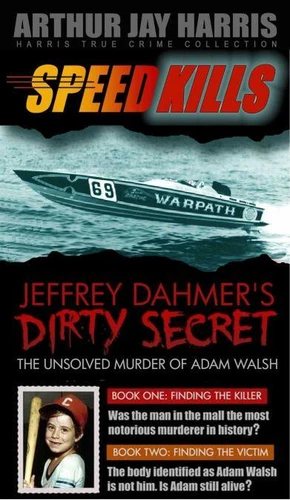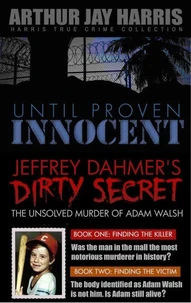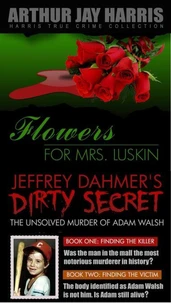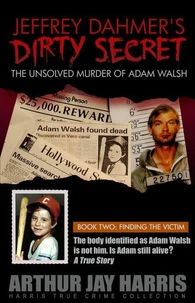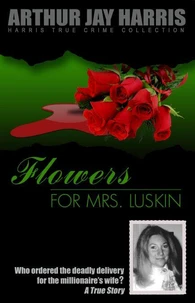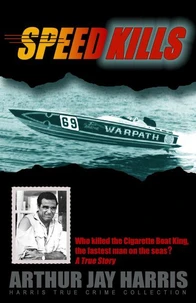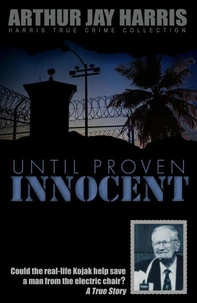Box Set: Speed Kills and The Unsolved Murder of Adam Walsh Books One and Two
Par :Formats :
Disponible dans votre compte client Decitre ou Furet du Nord dès validation de votre commande. Le format ePub est :
- Compatible avec une lecture sur My Vivlio (smartphone, tablette, ordinateur)
- Compatible avec une lecture sur liseuses Vivlio
- Pour les liseuses autres que Vivlio, vous devez utiliser le logiciel Adobe Digital Edition. Non compatible avec la lecture sur les liseuses Kindle, Remarkable et Sony
 , qui est-ce ?
, qui est-ce ?Notre partenaire de plateforme de lecture numérique où vous retrouverez l'ensemble de vos ebooks gratuitement
Pour en savoir plus sur nos ebooks, consultez notre aide en ligne ici
- FormatePub
- ISBN978-1-311-39158-2
- EAN9781311391582
- Date de parution08/06/2016
- Protection num.pas de protection
- Infos supplémentairesepub
- ÉditeurJPCA
Résumé
A feature film, SPEED KILLS, based on the book, stars John Travolta and is now streaming. SPEED KILLSHe built the fastest boats -- for royalty, the rich, spies, smugglers, Feds and a former U. S. President. Then came six shots. It was the era of cool shades and Miami Vice, and Don Aronow's Cigarette boats were the symbol of the city's sun-drenched decadence. But faster than his speed boats was Aronow himself -- in races behind the throttle, in business deals and on the town with his collection of stunning women.
And then, in broad daylight, someone in a dark Lincoln gunned him down. Who had Don double-dealt? A dope smuggler? The Mafia? The husband or boyfriend of one of his many paramours? And after ten years of dogged work, did Miami police get it right -- or were they dead wrong?THE UNSOLVED MURDER OF ADAM WALSHA famous old crime. No linking physical evidence. For decades, 6-year-old Adam Walsh's murder was a mystery.
Suddenly police declared a solution resurrected on a theory they'd long discredited, clearly a convenient fiction to benefit the victim's family, who at a live nationally-televised police press conference were tearful and grateful. The national media bought it; the local press knew better. As Fred Grimm wrote in the South Florida Sun Sentinel on July 30, 2021, days after the 40th anniversary of Adam's disappearance:"A sensational alternate theory blamed serial killer Jeffrey Dahmer, who was living in Miami in 1981.
But in 2008, despite no new evidence, Hollywood police hung the crime on long-dead Ottis Toole."The only mystery left unsolved was how any cop could have possibly believed Ottis Toole."Before the 2008 announcement, Adam's father John Walsh had bitterly complained, often crying, that there was "no justice, no justice" for his family. But while Toole was still alive and in state custody, and could have been charged with Adam's murder and brought to trial on the same information, Walsh had belittled the idea:"A lot of people still think Ottis Elwood Toole did it.
But he and Henry Lee Lucas confessed to a lot of murders they didn't do. It's a great ploy for convicts: They read about a murder and they're in solitary. They call the police, desperate to clear a murder, and they say, 'Fly me there and buy me a pizza, ' and they get out of their cells for two days!"-South Florida magazine, July 1992Police had statements from six separate police witnesses at the mall who said they saw Dahmer at the time Adam disappeared, but police couldn't confirm that Dahmer had been in town at the time.
Then reporter Art Harris, working with ABC Primetime, found a Miami police report with Dahmer's name 20 days before Adam disappeared. Still the police weren't interested. But by 2008, both Dahmer and Toole were dead, there couldn't be a trial against either, so what did it matter? Although the police's conclusion was eye-rolling, it seemed harmless. Grimm was wrong only in that police's belief in Toole was the only mystery left.
Actually, it became the least of the mysteries. By closing the case, probably without realizing it, police unlatched a door, locked nearly 30 years before, guarding a previously-impenetrable secret that possibly only one man, maybe two, seemed to know about-not even the detectives. At that point you just needed to know to ask to open the door. Only one reporter did. Who knew what would be inside?Inside Harris discovered another, much larger convenient fiction, but this one not at all harmless.
It was the key to the story because in looking back it explained everything irregular in the case investigation that had followed. As long as the secret was kept, the case could never be solved. Harris was then working with The Miami Herald, but even when they confronted them, the chief medical examiner who'd hidden it, the police-and most surprisingly, even the ...
And then, in broad daylight, someone in a dark Lincoln gunned him down. Who had Don double-dealt? A dope smuggler? The Mafia? The husband or boyfriend of one of his many paramours? And after ten years of dogged work, did Miami police get it right -- or were they dead wrong?THE UNSOLVED MURDER OF ADAM WALSHA famous old crime. No linking physical evidence. For decades, 6-year-old Adam Walsh's murder was a mystery.
Suddenly police declared a solution resurrected on a theory they'd long discredited, clearly a convenient fiction to benefit the victim's family, who at a live nationally-televised police press conference were tearful and grateful. The national media bought it; the local press knew better. As Fred Grimm wrote in the South Florida Sun Sentinel on July 30, 2021, days after the 40th anniversary of Adam's disappearance:"A sensational alternate theory blamed serial killer Jeffrey Dahmer, who was living in Miami in 1981.
But in 2008, despite no new evidence, Hollywood police hung the crime on long-dead Ottis Toole."The only mystery left unsolved was how any cop could have possibly believed Ottis Toole."Before the 2008 announcement, Adam's father John Walsh had bitterly complained, often crying, that there was "no justice, no justice" for his family. But while Toole was still alive and in state custody, and could have been charged with Adam's murder and brought to trial on the same information, Walsh had belittled the idea:"A lot of people still think Ottis Elwood Toole did it.
But he and Henry Lee Lucas confessed to a lot of murders they didn't do. It's a great ploy for convicts: They read about a murder and they're in solitary. They call the police, desperate to clear a murder, and they say, 'Fly me there and buy me a pizza, ' and they get out of their cells for two days!"-South Florida magazine, July 1992Police had statements from six separate police witnesses at the mall who said they saw Dahmer at the time Adam disappeared, but police couldn't confirm that Dahmer had been in town at the time.
Then reporter Art Harris, working with ABC Primetime, found a Miami police report with Dahmer's name 20 days before Adam disappeared. Still the police weren't interested. But by 2008, both Dahmer and Toole were dead, there couldn't be a trial against either, so what did it matter? Although the police's conclusion was eye-rolling, it seemed harmless. Grimm was wrong only in that police's belief in Toole was the only mystery left.
Actually, it became the least of the mysteries. By closing the case, probably without realizing it, police unlatched a door, locked nearly 30 years before, guarding a previously-impenetrable secret that possibly only one man, maybe two, seemed to know about-not even the detectives. At that point you just needed to know to ask to open the door. Only one reporter did. Who knew what would be inside?Inside Harris discovered another, much larger convenient fiction, but this one not at all harmless.
It was the key to the story because in looking back it explained everything irregular in the case investigation that had followed. As long as the secret was kept, the case could never be solved. Harris was then working with The Miami Herald, but even when they confronted them, the chief medical examiner who'd hidden it, the police-and most surprisingly, even the ...
A feature film, SPEED KILLS, based on the book, stars John Travolta and is now streaming. SPEED KILLSHe built the fastest boats -- for royalty, the rich, spies, smugglers, Feds and a former U. S. President. Then came six shots. It was the era of cool shades and Miami Vice, and Don Aronow's Cigarette boats were the symbol of the city's sun-drenched decadence. But faster than his speed boats was Aronow himself -- in races behind the throttle, in business deals and on the town with his collection of stunning women.
And then, in broad daylight, someone in a dark Lincoln gunned him down. Who had Don double-dealt? A dope smuggler? The Mafia? The husband or boyfriend of one of his many paramours? And after ten years of dogged work, did Miami police get it right -- or were they dead wrong?THE UNSOLVED MURDER OF ADAM WALSHA famous old crime. No linking physical evidence. For decades, 6-year-old Adam Walsh's murder was a mystery.
Suddenly police declared a solution resurrected on a theory they'd long discredited, clearly a convenient fiction to benefit the victim's family, who at a live nationally-televised police press conference were tearful and grateful. The national media bought it; the local press knew better. As Fred Grimm wrote in the South Florida Sun Sentinel on July 30, 2021, days after the 40th anniversary of Adam's disappearance:"A sensational alternate theory blamed serial killer Jeffrey Dahmer, who was living in Miami in 1981.
But in 2008, despite no new evidence, Hollywood police hung the crime on long-dead Ottis Toole."The only mystery left unsolved was how any cop could have possibly believed Ottis Toole."Before the 2008 announcement, Adam's father John Walsh had bitterly complained, often crying, that there was "no justice, no justice" for his family. But while Toole was still alive and in state custody, and could have been charged with Adam's murder and brought to trial on the same information, Walsh had belittled the idea:"A lot of people still think Ottis Elwood Toole did it.
But he and Henry Lee Lucas confessed to a lot of murders they didn't do. It's a great ploy for convicts: They read about a murder and they're in solitary. They call the police, desperate to clear a murder, and they say, 'Fly me there and buy me a pizza, ' and they get out of their cells for two days!"-South Florida magazine, July 1992Police had statements from six separate police witnesses at the mall who said they saw Dahmer at the time Adam disappeared, but police couldn't confirm that Dahmer had been in town at the time.
Then reporter Art Harris, working with ABC Primetime, found a Miami police report with Dahmer's name 20 days before Adam disappeared. Still the police weren't interested. But by 2008, both Dahmer and Toole were dead, there couldn't be a trial against either, so what did it matter? Although the police's conclusion was eye-rolling, it seemed harmless. Grimm was wrong only in that police's belief in Toole was the only mystery left.
Actually, it became the least of the mysteries. By closing the case, probably without realizing it, police unlatched a door, locked nearly 30 years before, guarding a previously-impenetrable secret that possibly only one man, maybe two, seemed to know about-not even the detectives. At that point you just needed to know to ask to open the door. Only one reporter did. Who knew what would be inside?Inside Harris discovered another, much larger convenient fiction, but this one not at all harmless.
It was the key to the story because in looking back it explained everything irregular in the case investigation that had followed. As long as the secret was kept, the case could never be solved. Harris was then working with The Miami Herald, but even when they confronted them, the chief medical examiner who'd hidden it, the police-and most surprisingly, even the ...
And then, in broad daylight, someone in a dark Lincoln gunned him down. Who had Don double-dealt? A dope smuggler? The Mafia? The husband or boyfriend of one of his many paramours? And after ten years of dogged work, did Miami police get it right -- or were they dead wrong?THE UNSOLVED MURDER OF ADAM WALSHA famous old crime. No linking physical evidence. For decades, 6-year-old Adam Walsh's murder was a mystery.
Suddenly police declared a solution resurrected on a theory they'd long discredited, clearly a convenient fiction to benefit the victim's family, who at a live nationally-televised police press conference were tearful and grateful. The national media bought it; the local press knew better. As Fred Grimm wrote in the South Florida Sun Sentinel on July 30, 2021, days after the 40th anniversary of Adam's disappearance:"A sensational alternate theory blamed serial killer Jeffrey Dahmer, who was living in Miami in 1981.
But in 2008, despite no new evidence, Hollywood police hung the crime on long-dead Ottis Toole."The only mystery left unsolved was how any cop could have possibly believed Ottis Toole."Before the 2008 announcement, Adam's father John Walsh had bitterly complained, often crying, that there was "no justice, no justice" for his family. But while Toole was still alive and in state custody, and could have been charged with Adam's murder and brought to trial on the same information, Walsh had belittled the idea:"A lot of people still think Ottis Elwood Toole did it.
But he and Henry Lee Lucas confessed to a lot of murders they didn't do. It's a great ploy for convicts: They read about a murder and they're in solitary. They call the police, desperate to clear a murder, and they say, 'Fly me there and buy me a pizza, ' and they get out of their cells for two days!"-South Florida magazine, July 1992Police had statements from six separate police witnesses at the mall who said they saw Dahmer at the time Adam disappeared, but police couldn't confirm that Dahmer had been in town at the time.
Then reporter Art Harris, working with ABC Primetime, found a Miami police report with Dahmer's name 20 days before Adam disappeared. Still the police weren't interested. But by 2008, both Dahmer and Toole were dead, there couldn't be a trial against either, so what did it matter? Although the police's conclusion was eye-rolling, it seemed harmless. Grimm was wrong only in that police's belief in Toole was the only mystery left.
Actually, it became the least of the mysteries. By closing the case, probably without realizing it, police unlatched a door, locked nearly 30 years before, guarding a previously-impenetrable secret that possibly only one man, maybe two, seemed to know about-not even the detectives. At that point you just needed to know to ask to open the door. Only one reporter did. Who knew what would be inside?Inside Harris discovered another, much larger convenient fiction, but this one not at all harmless.
It was the key to the story because in looking back it explained everything irregular in the case investigation that had followed. As long as the secret was kept, the case could never be solved. Harris was then working with The Miami Herald, but even when they confronted them, the chief medical examiner who'd hidden it, the police-and most surprisingly, even the ...

